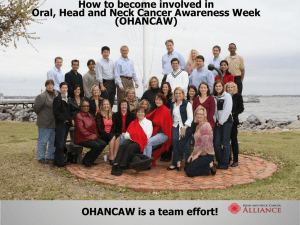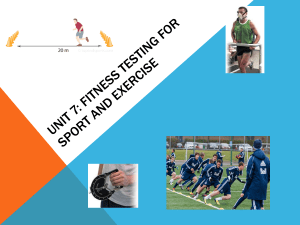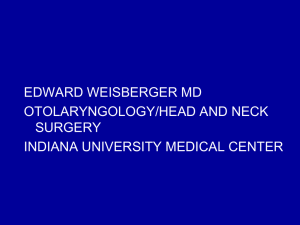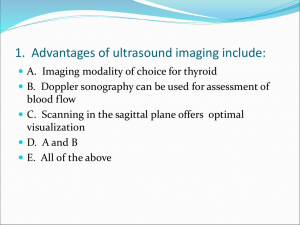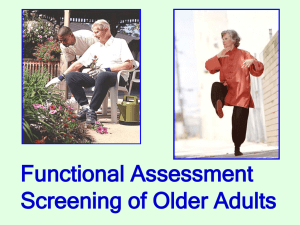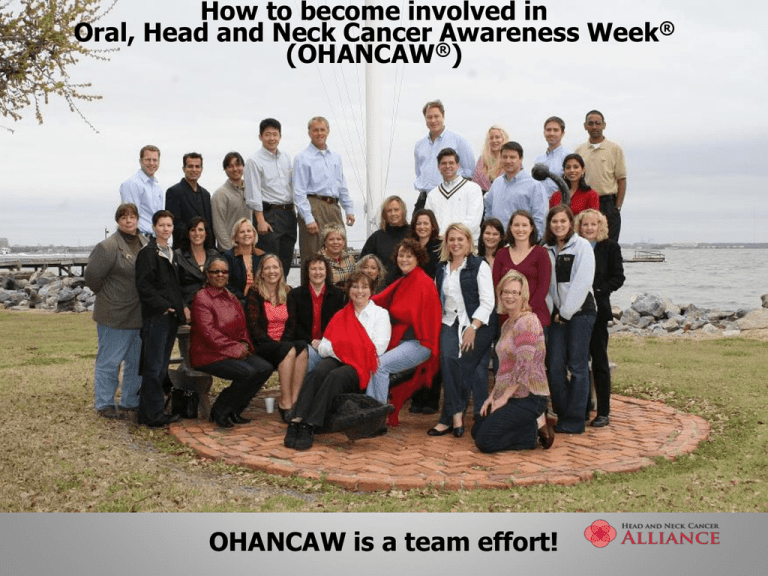
How to become involved in
Oral, Head and Neck Cancer Awareness Week®
(OHANCAW®)
OHANCAW is a team effort!
International Oral, Head & Neck
Cancer Awareness Week
(OHANCAW)
Purpose: promote public awareness and
the importance of early detection.
What is it? A week-long series of events
organized by a dedicated group of health
professionals, survivors, volunteers, and
others.
Events are organized at the discretion of
local leaders and customized to resources
and needs of a particular location.
http://www.ohancaw.com
OHANCAW 2014
April 20-26
• Events include free screenings, many of which
will be offered on Friday, April 25th.
• Screenings are not limited to this week.
• Other OHANCAW events include: walkathons,
community education, survivor banquets, and
research days.
• Sign up, and be on our navigable map! Over
500,000 people visited our website last year to
find an OHANCAW location near them.
WHY participate in OHANCAW?
Raise public awareness!
Make a difference!
Enhance PR of your organization!
Possibly save a life!
According to a 2013 survey:
• 75% of respondents from a European study were NOT
aware of the term “head and neck cancer”
• 15% of American’s have NEVER heard of oral, head &
neck cancer
- 62% were “not very” or “not at all” knowledgeable
and 58% of these respondents used tobacco products
- % knew that tobacco was a significant risk factor
- 26% remember ever having an oral, head & neck
exam (Day et al., 2005)
What is Oral, Head & Neck
Cancer?
Any cancer in the head and neck excluding
cancer of the brain
• Includes cancers of the mouth, skin,
throat, salivary glands, neck and thyroid
• Oral cancer is the most common
• Over 50,000 new cases and 12,000 deaths
a year (excluding thyroid)
•
Signs and Symptoms of Oral,
Head, & Neck Cancer
May include…
A sore in your mouth
that doesn’t heal or
increases in size
Persistent pain in your
mouth
Lumps or white or red
patches inside your
mouth
Thickening of your cheek
Difficulty chewing or
swallowing or moving
your tongue
Changes in your voice
A lump in your neck
Bad breath
Difficulty moving your
jaw, or swelling or
pain in your jaw
How to Set up a Free
Screening: Step 1
Establish screening committee
Assign roles within committee
Screening Coordinator
Volunteer Coordinator
Fundraising Coordinator
How to set up a Free
Screening: Step 2
Develop a timeline.
Organize regular meeting times.
Identify screening locations.
Determine staffing needs for screening.
Brainstorm fundraising ideas to support
event (such as for supplies & printing).
Market your screening event.
Identify Screeners
Primary Screeners
Otolaryngologists, Oral Maxillofacial Surgeons
Dentists, Radiation Oncologists, Nurse Practitioners
Secondary Screeners
Nurses, Speech Pathologists, Medical Students
General Volunteers
Survivors, Family Members, Graduate Students
Additional support if available
Nutrition Counselors/Smoking Cessation Counselors
Primary Screeners
Conduct interview/education regarding risk factors
Implement exam
Make medical recommendations for follow-up
No diagnosis given at time of screening
Areas of concern identified
Secondary Screeners
Set up room
Restock after each
screening
Assist completing
paperwork
Collect follow up
data
General Volunteers
(such as survivors, students, health professionals)
Volunteer Tasks:
Meet/Greet
Check in
Assist with filling out pre-registration form
(available online)
Organize waiting room
Distribute educational materials (available
online)
Provide smoking cessation information
Screening Site Example
Waiting Area
Check In/ Volunteers
Participant
Participant
Supply
Table
Supply
Table
Supplies
Adequate light source
(head lamps)
Disposable dental
mirrors
Tongue blades
Alcohol wipes
Hand Sanitizer
4x4 gauze pads
Gloves
Liquid defog
(optional)
Trash bags
Clip boards/pens
Folder for completed
forms
Information brochures
on oral cancer
Follow up
forms/contacts
Otoscopes (optional)
Participant Flow
Sign In
Referrals given
if necessary
MD reviews
history, screens +
risk management
counseling, rec.
for f/u
Complete
screening form
Talks with
volunteers and reads
educational materials
while waiting
Volunteer
escorts
to screening
room
Performing the
Head and Neck Exam: Step 1
History and teaching!
Ask about oral and neck lesions
Pain or bleeding
Change in function
Risky behaviors (smoking, drinking)
Performing the Head & Neck
Exam: Step 2
• Inspect and palpate for masses of
the :
• Cervical lymph nodes
• Thyroid
Salivary Glands
Use a hands-free light source!
Performing the Head & Neck
Exam: Step 3
Perform a cranial nerve exam
Intraoral inspection and palpation
Lips, cheeks and floor of mouth
Wrap tongue in gauze and retract to
assess lateral tongue borders, tonsillar
pillars, hard palate, soft palate and
gingiva
Positive Findings at Screening?
Organize list with contact information
Local HN Surgeons, Oral Maxillofacial Surgeons
(business cards when available)
Or may provide contact information for Academy
of Otolaryngology Head and Neck Surgery to
locate physicians
**Counsel participant: screening only, not an
actual diagnosis
**Important to strongly recommend follow up if
needed
Provide written summary of areas of concern for
participant to give to physician
OHANCAW Events also
include…
• News releases
• Public service
announcements
• Physician directed “teach
ins” for middle schoolaged children
• Cancer survivor banquet
• Oral Cancer Walk-athons
• Research conferences
• Benefit concerts
• Governor’s Proclamation
• Highlight: Day of Free
Oral Cancer Screenings
Community Education:
Middle School Talks
Target 6th, 7th and 8th graders
Make it as interactive as possible
Lots of pictures
Talk about dangers of smoking and oral sex (if age
appropriate)
Download community education materials at
www.ohancaw.com
Why Create a Local
Head & Neck Cancer Alliance
(HNCA) Chapter?
Great opportunity for professionals and
volunteers with a common passion/goals
to:
Raise awareness
Promote professional engagement and
research
Support survivorship
Develop resources for head and neck cancers
Increase advocacy
Allows for a collective voice on all pertinent
issues related to head and neck cancers
References
Adapted from Ashley Laursen, BSN, RN and
Mary Beth Chalk, FNP-C presentation at the
SOHN Annual Meeting, 2009, and Meryl
Kaufman, M.Ed, CCC-SLP and Edie Hapner,
PhD CCC-SLP PP presentation at the
International Association of Laryngectomees
Annual Convention, 2008

